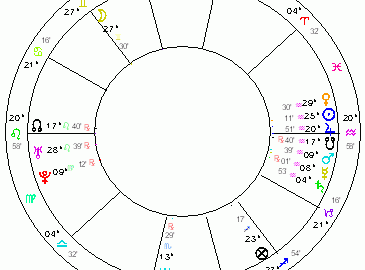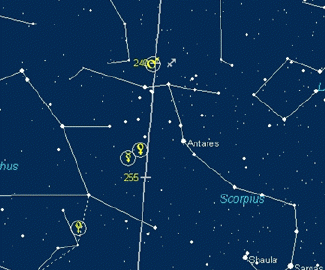Darrelyn Gunzburg
October 2005
Between the last New Moon of the Visual Astrology Newsletter and this New Moon of Rosh Hashanah, the beginning of the Jewish New Year, the world lost Simon Wiesenthal (alav hashalom), Holocaust survivor and Nazi hunter.
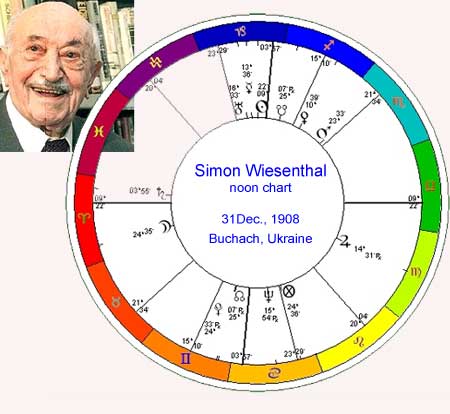
We are all aware of how awed we feel when acts of terrorism or natural disasters hit our headlines. Yet engaged empathy can spread only so far. Within two weeks news presenters have carefully segued such items to places of lesser weight until eventually they evaporate from broadcast space. For news in any form always seeks the peak experience. This is why Simon Wiesenthal was so extraordinary, for he was a man who fought against forgetting and with a determined obsession, remained a witness his whole life to the atrocities of the Shoah. When western powers lost interest and turned away, he raised his voice and shouted into the echo chamber of history.
With no birth time available we can however still look at his fixed stars. The first way we can look at Wiesenthal’s life is to consider the two great foundation stones on which his life was built – his heliacal rising star and his heliacal setting star. (These stars were discussed in the August, 2005 issue)
His heliacal rising star is Facies. Starlight says of this star, in this position:
HELIACAL RISING STAR
Facies – A philosophy that life is hard or unforgiving
Facies in the constellation Sagittarius holds one of the most difficult and violent myths in the heavens. Encapsulating the penetrating “stare” of a lethal weapon, it offers either piercing action that has no regard for others or is expressed through the individual who may be the victim of such a stare.
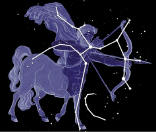
Initially Facies (in the face of archer left) expressed itself in Wiesenthal’s life as the victim of a cruel and ruthless administration when he and his wife were sent by Nazis to labour camps in 1941. But it was the Nazi genocide machine begun in 1942 known as “the Final Solution” that epitomised Facies in its most heartless and chilling state.
Wiesenthal was firstly imprisoned in the Janowska concentration camp until 1943 and later in a small forced labour camp attached to an important railway repair yard. He was singled out by the railway yard’s Nazi manager and assigned to design work and to act as a go-between with Polish contractors. In such a situation he was able to build contacts with Polish underground members who helped his wife to escape into hiding in Warsaw. Wiesenthal himself escaped from the camp in October 1943 but was recaptured by the SS in 1944. Convinced that he faced torture and extermination in the death camps, he made three failed suicide attempts in short succession. He was sent to eleven concentration camps over the next year or so, before spending six days half alive in the freezing confines of packed, open freight wagons destined for Austria’s notorious Mauthausen camp. When Mauthausen was liberated by an American armoured unit on 5th May, 1945, Wiesenthal was barely alive. He weighed less than a hundred pounds and had been left lying helplessly in a barracks where the stench was so strong that even hardboiled SS guards would not enter. Wiesenthal and his wife lost a total of eighty-nine members of their families in the Shoah.
Unwillingly caught in the maelstrom of the Holocaust, Wiesenthal made the conscious decision to become its voice, rather than its victim. He turned this philosophy that “life is hard or unforgiving” into a framework from which he could pursue justice. Credited with helping to bring more than 1,100 Nazi war criminals to justice in the decades after the genocide of the Jews in World War II, including Adolf Eichmann, an architect of the Holocaust, and Franz Stangl, commandant of the Treblinka and Sobibor Nazi death camps in Poland, here we see Facies strongly focused as the non-diplomatic but achieving person.
We can also consider Wiesenthal’s helical setting star, the star that has been living amongst the immortals at the pole and has now returned to the earth. This star is the gift from one’s immortal soul or daemon. In Wiesenthal’s chart his heliacal setting star is Algol. Starlight says of this star, in this position:
HELIACAL SETTING STAR
Algol – Led by one’s passions, to create or destroy
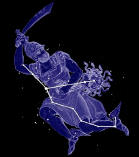
Algol, the head of the Gorgon in the constellation Perseus (right) contains immense female passion and power and embodies everything that men fear in the feminine. She is female kundalini energy, the wild, raw, frightening face of the outraged feminine which has been labelled as demonic or simply as evil. Such strong consuming passion could have devoured Wiesenthal with anger and rage. However, if one can contain an unconscious compulsion to take revenge and focus that passion into a more productive outcome, Algol holds one of the most powerful myths in the sky. In Wiesenthal’s chart it pulls him forward to a place where he can express his violence and rage as justice.
In contrast to the Nazi killing machine, devoid of passion, intellectually arrogant, heartless and chilling, it was the wild, raw, frightening face of the outraged feminine of Algol that rose up through Wiesenthal after his liberation from the camps. He determinedly culled every pertinent document and record he could find and listened to the many personal accounts told to him by individual survivors. Using his architect’s structural acumen and a brilliance in investigative thinking, he pieced together the most obscure, incomplete, apparently irrelevant and unconnected data to build cases solid enough to stand up in a court of law. The dossiers were then presented to the appropriate authorities. When, as often happened, they failed to take action, whether from indifference, pro-Nazi sentiment or some other consideration, Wiesenthal went to the press and other media, for experience had taught him that publicity and an outraged public opinion were powerful weapons. Here is Algol not only firing him in his search but also being used to fire the public with the passion of justice.
When asked why he had devoted his life to hunting Nazis and bringing them to trial rather than going back to building houses and becoming a millionaire, Wiesenthal replied: “When we come to the other world and meet the millions of Jews who died in the camps and they ask us, ‘What have you done?’, there will be many answers. You will say, ‘I became a jeweller’. Another will say, ‘I built houses’, But I will say, ‘I didn’t forget you.’” (2)
From the formative years of Facies to the passion of principles of Algol, Wiesenthal’s obsession with bringing mass murderers to justice ricocheted into the mainstream with the establishment of the UN international criminal court and international tribunals charged with identifying and trying those responsible for crimes against humanity in the former Yugoslavia, Rwanda and Sierra Leone.
To add to the story we can look at Wiesenthal’s parans. We don’t have a timed chart for him but it doesn’t matter. Starlight will look at the full 24 hours of the day of birth and search for every star-planet combination. If we take the parans to his Sun – his health, vitality, rank and position – we can see an unfoldment from his early years up to the Saturn Return with the Sun making a paran to Aculeus, and then the maturation of that Sun in his middle years with the Sun making a paran to Sirius.
Starlight says of theSun rising when Aculeus is rising:
A person who grows in strength through attacks or difficulties. A battler.
Aculeus is one of the stings of the Scorpion, linked with physical, mental, verbal or spiritual attacks which an individual can endure and use to harden or strengthen themselves. Since this is connected with his Sun in his youth, this tells us that these years have been hard for Wiesenthal with regard to his father but that he has the ability to identify with the struggle and to grow stronger. Wiesenthal’s biological father was killed World War I; his step-father was arrested by the NKVD (People’s Commissariat of Internal Affairs – Soviet Secret Police) in the purge of “bourgeois” elements that followed the Soviet occupation of Lvov Oblast at the beginning of World War II and eventually died in prison. However, through his initial struggles Wiesenthal wins through by growing in strength.
Starlight says of the Sun culminating when Sirius is On Nadir:
Sudden success which can burn.
Sirius is one of the great stars of the sky, the brightest star in the heavens apart from our Sun. The Egyptians called it The Shining One or The Scorcher. It was linked to the life-giving rising of the Nile and in that capacity it was also called the Nile Star. Sirius is a marker of great deeds. It indicates that the mundane may become sacred, that the small action of the individual has a large effect on the collective. The individual, however, may be sacrificed to this collective expression or may gain fame and glory. With Sirius in paran with his Sun in his prime, as long as he did not seek personal fame or glory, Wiesenthal could reshape the struggles of his youth to help him achieve levels that were not thought possible. He applied this to finding Nazi war criminals and by his efforts, gained far more than what was expected. This is the star-planet paran of the mundane becoming sacred, where a small action becomes a symbol for the collective.
As you can see, these star-planet combinations add to the story of the heliacal rising and setting stars and give detail to the larger picture.
Wiesenthal died in his sleep at his home in the Austrian capital, Vienna, on 20th September, 2005, aged 96. I wanted to take this opportunity to pay my personal respects to a man whose work I have followed for many years and at the same time show how difficult stars myths and difficult star-planet combinations can be shaped to make a positive difference for others.
Simon Wiesenthal may have left us but his light remains.
___________________________
(1) Hella Pick at: http://www.guardian.co.uk/obituaries/story/0,3604,1574315,00.html
(2) According to Clyde Farnsworth in the New York Times Magazine (February 2, 1964),


